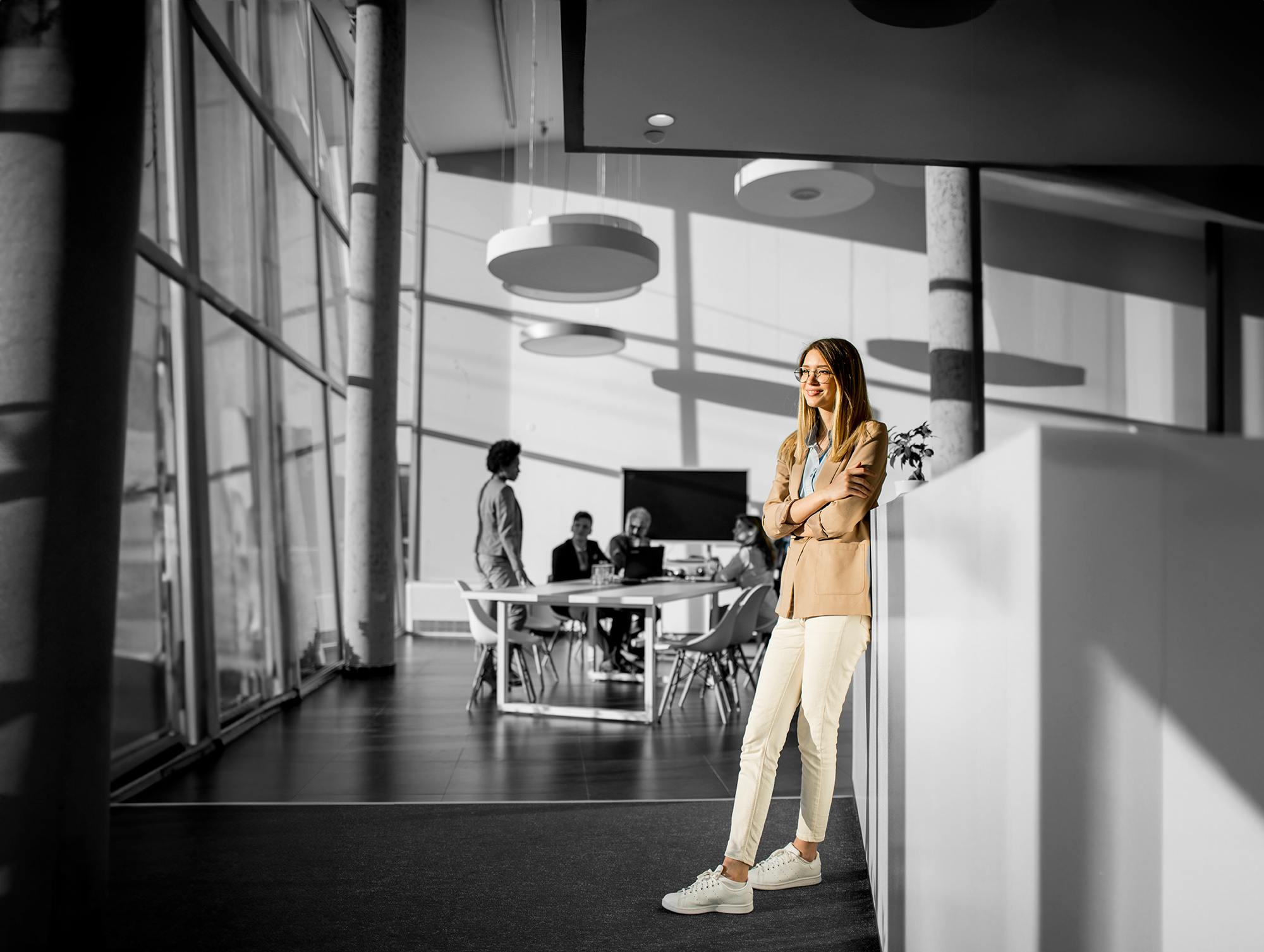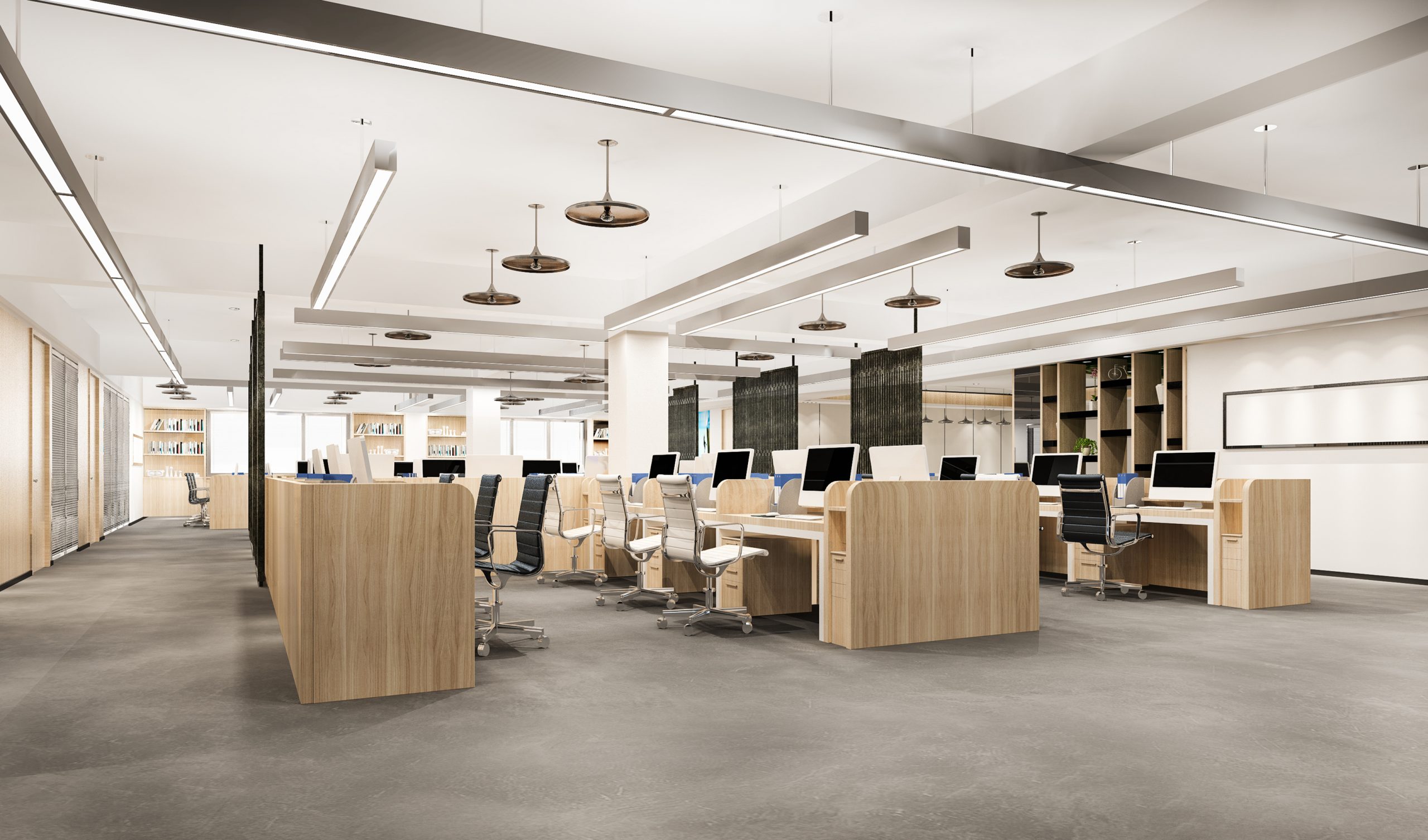- Advice
- Workplace

Light Up Your Workspace: The Benefits of Proper Lighting for Employee Wellness and Performance
Lighting is a crucial element in the design of an office space. It can have a significant impact on the productivity, mood, and well-being of employees.
Poor lighting can cause headaches, eye strain, and fatigue, while optimal lighting can promote alertness, reduce stress, and improve mood. In this article, we will explore the connection between lighting and office productivity and provide tips on how to optimize your lighting design.
Lighting can influence our productivity by regulating our circadian rhythms, which are the natural 24-hour cycles that govern our sleep-wake cycle. Exposure to bright, blue-rich light during the day can help to regulate our circadian rhythms, making us more alert and focused during the day and improving our sleep quality at night. On the other hand, exposure to dim or warm lighting can help to relax us, and prepare us for sleep.
Furthermore, lighting can affect our mood and emotional state. Exposure to bright, blue-rich light during the day can help to boost our mood and reduce feelings of fatigue. However, exposure to bright or harsh lighting at night can disrupt our circadian rhythms, leading to difficulty in falling asleep and poor sleep quality.
Tips for Optimizing Your Lighting Design
To create an optimal lighting design, here are some tips to consider:
-
Use Natural Light

Natural light is the best source of light for regulating our circadian rhythms. It can improve mood, boost alertness and reduce stress. Where possible, position workstations near windows to maximize the amount of natural light in the workspace. If your office doesn’t have natural light or if you want to supplement it, consider installing skylights or light tubes to bring natural light into the space.
-
Balance Brightness and Glare

While bright lighting can help to improve productivity, too much glare can cause eyestrain and headaches. To avoid this, use shades or blinds to reduce direct sunlight, and position light fixtures so that they do not shine directly into the eyes of workers. A balanced lighting design can reduce glare and promote optimal lighting levels, improving productivity and reducing discomfort.
-
Use the Right Color Temperature
The color temperature of light can also have an impact on productivity. During the day, use bright, blue-rich light (around 5000K) to help regulate circadian rhythms and improve alertness. In the evening, switch to warmer, dimmer lighting (around 2700K) to help workers wind down and prepare for sleep. Using the right color temperature can optimize the lighting levels to improve the productivity of workers.
-
Layer Your Lighting
To create a comfortable and inviting workspace, it’s important to use a variety of lighting sources. This could include overhead lighting, task lighting for individual workstations, and ambient lighting to create a warm, welcoming atmosphere. A layered lighting design can create a comfortable and productive workspace.
-
Consider Energy Efficiency

When designing your lighting system, it’s important to consider energy efficiency. Using energy-efficient bulbs such as LED or fluorescent bulbs can reduce energy consumption and lower energy bills. Additionally, installing motion sensors or timers can ensure that lights are only on when they are needed, reducing energy waste.
-
Design Lighting to Fit the Task

Different tasks require different levels and types of lighting. For example, computer work requires brighter lighting than reading or writing. Therefore, it’s important to design your lighting system to fit the task. Use task lighting at individual workstations to ensure that workers have the proper lighting levels for their specific tasks. Conference rooms may require dimmer lighting to promote a calm and focused atmosphere, while break rooms and common areas may benefit from brighter, more inviting lighting.
-
Consult with Professionals
Designing an effective lighting system can be a complex process. Therefore, it may be beneficial to consult with lighting professionals to ensure that your lighting design meets the needs of your workspace. A professional lighting designer can help you to identify the optimal lighting levels, lighting types, and lighting sources for your office space.
Lighting is a crucial element in the design of an office space, and it can have a significant impact on productivity, mood, and well-being. By using natural light, balancing brightness and glare, using the right color temperature, layering your lighting, considering energy efficiency, designing lighting to fit the task, and consulting with professionals, you can optimize your lighting design to create a comfortable and productive workspace.
Investing in a well-designed lighting system can pay off in improved productivity, reduced absenteeism, and increased job satisfaction. Therefore, it’s worth taking the time to create a lighting design that works for your specific office space and the needs of your employees.Poor lighting can cause headaches, eye strain, and fatigue, while optimal lighting can promote alertness, reduce stress, and improve mood. In this article, we will explore the connection between lighting and office productivity and provide tips on how to optimize your lighting design.
Lighting can influence our productivity by regulating our circadian rhythms, which are the natural 24-hour cycles that govern our sleep-wake cycle. Exposure to bright, blue-rich light during the day can help to regulate our circadian rhythms, making us more alert and focused during the day and improving our sleep quality at night. On the other hand, exposure to dim or warm lighting can help to relax us, and prepare us for sleep.
Furthermore, lighting can affect our mood and emotional state. Exposure to bright, blue-rich light during the day can help to boost our mood and reduce feelings of fatigue. However, exposure to bright or harsh lighting at night can disrupt our circadian rhythms, leading to difficulty in falling asleep and poor sleep quality.
Tips for Optimizing Your Lighting Design
To create an optimal lighting design, here are some tips to consider:
-
Use Natural Light

Natural light is the best source of light for regulating our circadian rhythms. It can improve mood, boost alertness and reduce stress. Where possible, position workstations near windows to maximize the amount of natural light in the workspace. If your office doesn’t have natural light or if you want to supplement it, consider installing skylights or light tubes to bring natural light into the space.
-
Balance Brightness and Glare

While bright lighting can help to improve productivity, too much glare can cause eyestrain and headaches. To avoid this, use shades or blinds to reduce direct sunlight, and position light fixtures so that they do not shine directly into the eyes of workers. A balanced lighting design can reduce glare and promote optimal lighting levels, improving productivity and reducing discomfort.
-
Use the Right Color Temperature
The color temperature of light can also have an impact on productivity. During the day, use bright, blue-rich light (around 5000K) to help regulate circadian rhythms and improve alertness. In the evening, switch to warmer, dimmer lighting (around 2700K) to help workers wind down and prepare for sleep. Using the right color temperature can optimize the lighting levels to improve the productivity of workers.
-
Layer Your Lighting
To create a comfortable and inviting workspace, it’s important to use a variety of lighting sources. This could include overhead lighting, task lighting for individual workstations, and ambient lighting to create a warm, welcoming atmosphere. A layered lighting design can create a comfortable and productive workspace.
-
Consider Energy Efficiency

When designing your lighting system, it’s important to consider energy efficiency. Using energy-efficient bulbs such as LED or fluorescent bulbs can reduce energy consumption and lower energy bills. Additionally, installing motion sensors or timers can ensure that lights are only on when they are needed, reducing energy waste.
-
Design Lighting to Fit the Task

Different tasks require different levels and types of lighting. For example, computer work requires brighter lighting than reading or writing. Therefore, it’s important to design your lighting system to fit the task. Use task lighting at individual workstations to ensure that workers have the proper lighting levels for their specific tasks. Conference rooms may require dimmer lighting to promote a calm and focused atmosphere, while break rooms and common areas may benefit from brighter, more inviting lighting.
-
Consult with Professionals
Designing an effective lighting system can be a complex process. Therefore, it may be beneficial to consult with lighting professionals to ensure that your lighting design meets the needs of your workspace. A professional lighting designer can help you to identify the optimal lighting levels, lighting types, and lighting sources for your office space.
Lighting is a crucial element in the design of an office space, and it can have a significant impact on productivity, mood, and well-being. By using natural light, balancing brightness and glare, using the right color temperature, layering your lighting, considering energy efficiency, designing lighting to fit the task, and consulting with professionals, you can optimize your lighting design to create a comfortable and productive workspace.
Investing in a well-designed lighting system can pay off in improved productivity, reduced absenteeism, and increased job satisfaction. Therefore, it’s worth taking the time to create a lighting design that works for your specific office space and the needs of your employees.
-
Picking the Perfect Location for Your Business
07 November 2023 -
Dilemma: New vs Old Construction
10 January 2023 -
Modern office spaces trends
13 September 2023 -
What makes the perfect office?
15 April 2024 -
Why holiday spirit is so important at the workplace?
12 December 2023 -
What is a hybrid workplace model and how does it work?
23 November 2022 -
Color Trends in Interior Design in 2023
06 July 2023 -
Work from Home or Work from the Office?
01 February 2024 -
Why choose consulting companies when buying or selling real estate?
14 November 2022 -
Transformation of the shopping trends and habits
15 November 2022 -
Workspace as inspiration for employees
22 November 2022 -
6 ways to make an office space visually appealing.
30 January 2023















